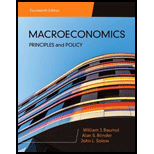2. Imports and Exports Now we allow for international trade. Use the following information from problem 1: C = 400 + (8/9)*DI I= 300 G= 800 T= (1/2)*Y. Suppose that exports are constant at X = 300. Let imports be a fraction of real income: M = (1/9) * Y. a. Give intuition for why imports M are positively related to national income Y in the equation above. b. Suppose that national income increases by $1. How much will spending on imports increase (the marginal propensity to import) in this case? c. Compute the equilibrium level of national income under international trade. d. Suppose that government spending increases by $120. i) Compute the new equilibrium national income. ii) Based on your numerical answer to (i), calculate the change in national income from a one dollar increase in government spending. iii) Derive the new fiscal multiplier from an increase in government spending using an algebraic equation. Compare to Problem 2.d.(ii). Compare to Problem 1.c.(v). e. Trade Representative: "In an open economy with international trade, government spending is much more effective at fighting recessions than in a closed economy." Evaluate.
2. Imports and Exports Now we allow for international trade. Use the following information from problem 1: C = 400 + (8/9)*DI I= 300 G= 800 T= (1/2)*Y. Suppose that exports are constant at X = 300. Let imports be a fraction of real income: M = (1/9) * Y. a. Give intuition for why imports M are positively related to national income Y in the equation above. b. Suppose that national income increases by $1. How much will spending on imports increase (the marginal propensity to import) in this case? c. Compute the equilibrium level of national income under international trade. d. Suppose that government spending increases by $120. i) Compute the new equilibrium national income. ii) Based on your numerical answer to (i), calculate the change in national income from a one dollar increase in government spending. iii) Derive the new fiscal multiplier from an increase in government spending using an algebraic equation. Compare to Problem 2.d.(ii). Compare to Problem 1.c.(v). e. Trade Representative: "In an open economy with international trade, government spending is much more effective at fighting recessions than in a closed economy." Evaluate.
Brief Principles of Macroeconomics (MindTap Course List)
8th Edition
ISBN:9781337091985
Author:N. Gregory Mankiw
Publisher:N. Gregory Mankiw
Chapter13: Open-economy Macroeconomics: Basic Concepts
Section: Chapter Questions
Problem 1CQQ
Related questions
Question
Question 2 D- i),ii) and iii)

Transcribed Image Text:2. Imports and Exports
Now we allow for international trade. Use the following information from problem 1:
C= 400 + (8/9)*DI
I= 300
G= 800
T= (1/2)*Y.
Suppose that exports are constant at X = 300.
Let imports be a fraction of real income: M = (1/9) * Y.
a. Give intuition for why imports M are positively related to national income Y in the equation
above.
b. Suppose that national income increases by $1. How much will spending on imports increase
(the marginal propensity to import) in this case?
c. Compute the equilibrium level of national income under international trade.
d. Suppose that government spending increases by $120.
i) Compute the new equilibrium national income.
ii) Based on your numerical answer to (i), calculate the change in national income from a
one dollar increase in government spending.
iii) Derive the new fiscal multiplier from an increase in government spending using an
algebraic equation. Compare to Problem 2.d.(ii). Compare to Problem 1.c.(v).
e. Trade Representative: "In an open economy with international trade, government spending is
much more effective at fighting recessions than in a closed economy." Evaluate.
Expert Solution
This question has been solved!
Explore an expertly crafted, step-by-step solution for a thorough understanding of key concepts.
This is a popular solution!
Trending now
This is a popular solution!
Step by step
Solved in 3 steps

Knowledge Booster
Learn more about
Need a deep-dive on the concept behind this application? Look no further. Learn more about this topic, economics and related others by exploring similar questions and additional content below.Recommended textbooks for you

Brief Principles of Macroeconomics (MindTap Cours…
Economics
ISBN:
9781337091985
Author:
N. Gregory Mankiw
Publisher:
Cengage Learning

Principles of Economics 2e
Economics
ISBN:
9781947172364
Author:
Steven A. Greenlaw; David Shapiro
Publisher:
OpenStax

Essentials of Economics (MindTap Course List)
Economics
ISBN:
9781337091992
Author:
N. Gregory Mankiw
Publisher:
Cengage Learning

Brief Principles of Macroeconomics (MindTap Cours…
Economics
ISBN:
9781337091985
Author:
N. Gregory Mankiw
Publisher:
Cengage Learning

Principles of Economics 2e
Economics
ISBN:
9781947172364
Author:
Steven A. Greenlaw; David Shapiro
Publisher:
OpenStax

Essentials of Economics (MindTap Course List)
Economics
ISBN:
9781337091992
Author:
N. Gregory Mankiw
Publisher:
Cengage Learning


